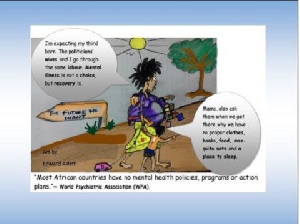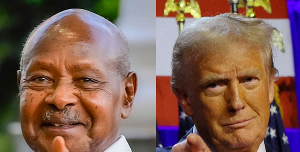Men who are responsible for the pregnancies and the babies mentally ill women carry in our streets, if they are not mentally ill themselves, are irresponsible for being responsible for the act and are irresponsible for not being responsible for their action.
It is forgivable when a roaming ‘madman’ suddenly bares a set of roasted teeth in weird romance in front of a sexually aroused ‘madwoman’ and leaves her with a baby, or even twins, nine months after.
But I am unable to tell as to whether there is more than we know or not in what a ‘normal’ man would find so attractive or sexy as to sleep with a street ‘madwoman’ who, owing to years of separation from water and soap, has accrued in her body and clothes a ‘diesel deposit’ in commercial quantities, and, for the lack of blade and comb, carries on her head a mass of naturally grown wild wig and muscular dreadlocks that gives her the ‘highly regarded’ look of a ‘professor’.
We see completely mentally ill women with their babies living and sleeping rough in the streets of Ghana and the rest of Africa. I call them the ‘ghost families’ because their ‘hosts’, the men responsible for their silent adventures, their untold struggles and their quiet misery, are around but are anonymous. For me, the question as to how they came by the pregnancies is not as important as the future of such ‘ghost families’.
‘The Future We Want’
Sadly, the world, Africa in particular, appears to have left the roaming mentally deranged women and their babies or the ‘ghost families’ out of the ‘Future We Want’— the United Nations’ Sustainable Development Goals (SDGs).
Governments, under the patronage of the United Nations Human and Environment Conference, met in 1972 to consider the rights of the human family to a healthy and productive environment. The world came together to make the world a better place by focusing on some key areas.
Those areas included poverty eradication, energy, water and sanitation, health and human settlement. The areas were adopted as ‘the Future We Want’. And throughout the journey so far, the UN has done things that suggest it is committed to that resolution.
As part of the ‘Future We Want’, the Millennium Development Goals (MDGs) were introduced in 2000, seventeen years ago. They were eight goals that sought to eradicate extreme poverty and hunger; achieve universal primary education; promote gender equality and empower women; reduce child mortality; improve maternal health; combat HIV/AIDS, malaria and other diseases; ensure environmental sustainability and develop a global partnership for development.
The nations were expected to meet these targets by a deadline of 2015, beginning from the year 2000. Today, the deadline is long over, but the war against the global problems identified 17 years ago is still far from over. Whilst there is no doubt that the nations have made some strides in the millennium race to meet the deadline, some critical questions remain unanswered.
The closing date is over. But why are millions still extremely poor and hungry? Why are millions still out of school? Why are gender equality and women empowerment still a dream in many communities? Why are millions of children still dying before their fifth birthday anniversaries? Why are too many pregnant women still losing their lives in their attempt to give life? Why are the flames of HIV/AIDS, malaria and other diseases still consuming some countries? Why is the environment still bleeding from the grips of humans? And why are suspicion, undue interference, war and quest for control still tearing the world apart?
Leaving them out of ‘The Future We Want’
The United Nations recently arrived at another landmark towards the destination to the ‘Future We Want’ journey it began in 1972. It introduced in September, 2015, what it calls the Sustainable Development Goals (SDGs) as a more-expanded descendant of the MDGs.
The SDGs are 17 in number and they seek to transform the world even in stronger tones than the MDGs by the year 2030. That is another 15 years from 2015. They are expected to end poverty in all its forms everywhere; end hunger; ensure healthy lives and promote wellbeing for all at all ages; ensure inclusive and equitable quality education; achieve gender equality and empower all women and girls among others.
African governments form part of the UN. Therefore, they are part of both the MDGs and the SDGs resolutions. But how many governments that took part in those resolutions really have taken any steps to ensure that the ‘ghost families’ in the streets are not left out of the ‘Future We Want’?
Look clearly through the streets of Africa. What do you see? Children born to mentally ill mothers scavenging through hills of garbage to survive when our governments have made expensive trips to UN General Assembly summits to defend a goal to eradicate extreme hunger. Pregnant mad women in the streets are excluded from antenatal cares services and supervised delivery when we are told there is a goal that seeks to improve maternal health.
Normal school-age children born to ‘madwomen’ are trekking barefoot through miles under all kinds of weather with no promised future when there is a goal that promises to ensure inclusive and equitable quality education. Our governments say they are committed to reducing child mortality when no one bothers about how the ‘normal’ babies strapped to the backs of wild ‘madwomen’ in the streets will ever get vaccinated against the six child killer diseases.
The voiceless minority and the negligent governments
On a continent where the ‘normal’ majority look down on authorities entrusted with mental healthcare services to a voiceless minority of mentally ill persons, the negligent governments are not helping matters, either.
It shows in the ridiculous amount governments allocate for mental health in their budgets. The United States spends 6% of its health budget on mental health. Kenya spends 0.01% whilst the Gambia spends 0.64%. The other African countries are not doing much better than Kenya and the Gambia. Only three years ago, the Human Rights Watch released a damning report on Ghana, where an estimated three million people live with mental disabilities.
The report highlights overcrowding and unsanitary conditions in three public psychiatric hospitals and some spiritual healing centres where mentally ill people are chained to trees by their ankles and are left to sleep, defecate, bathe and urinate on the same spot.
The World Health Organisation (WHO) says 85% of mentally ill or disabled people in the developing world never get treatment. The same WHO has made it clear that “without adequate financing, mental health policies and plans remain in the realm of rhetoric and good intentions”.
The Chief Executive Officer of the Ghana Mental Health Authority, Dr. Akwasi Osei, launched in 2011 an exercise to remove mentally ill people (including mentally ill pregnant women and nursing mothers) from the streets of Ghana for rehabilitation. In 2015, the authority was compelled to suspend the exercise. And it has remained suspended to date. Here is the reason he gave me when I asked him why, just this October:
“We are not getting support,” he said with frustration. “We have spoken to the various development partners; we are not getting support. The government itself is not ready to support. Nobody is ready to support. We had to suspend it for some time until we are able to raise funds in the future. We were able to take about 100 patients out of the streets before we had to suspend that exercise. As a nation, we have misplaced our priorities. If we all recognise that mental health is very significant, then we would give the necessary assistance to mental health.”
Governments in Africa have done nothing or too little to ensure that the ‘ghost families’ in the streets are part of the ‘Future We Want’— the SDGs. And until they are part of that desired future, the war against the world’s ever-present threats will always be far from won.
Maybe, one of the strict conditions the foreign donor agencies should henceforth attach to their aids for any government in Africa should be an allocation from the funds for mental health. A mental health fund. Much as the SDGs are the ‘Future We Want’ as a globe, in Africa ‘minimum force’ is the only diplomatic language the majority of our governments understand.
Opinions of Tuesday, 10 October 2017
Columnist: Edward Adeti
‘Madwomen’ with babies and the ‘future we want’
Entertainment














